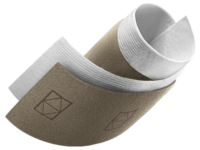Compression therapy: 3 ways to increase patient adherence
Edema specialist offers tips to help improve chronic wound healing.

By Suzie Ehmann, DPT, CWS, CLT-LANA
I like to say that if you can get compression around it, you can make it heal better. Indeed, in my opinion, compression is a gold standard when it comes to managing venous stasis wounds. But success depends on patient adherence to their compression therapy.
You can help patients stick with prescribed compression therapy by taking three important actions. They all revolve around education, and I like to call them the three “knows.”
- Know your patients so you can engage them in their treatment.
- Know your patients’ medical story so you can help them overcome barriers to therapy.
- Know the products so you can help tailor the right approach for each patient.
What is compression therapy?
When we talk about compression, it’s important to first remember the benefits of compression therapy. At the root, compression improves blood circulation in the legs—lymphatic, venous and arterial flow. When we talk about some of the things we need for a wound to heal, one of the important factors is good circulation.
You can think of the analogy of water that’s left sitting in a dish. It builds up a film on top because the water isn’t moving. To keep the water clean and clear, you have to keep circulating it like a fountain. That’s really what compression does: It can help enhance circulation of new blood in, and the old stuff out.

We also need to stress what compression is not.
An Unna boot with some gauze wrapped around it is not compression. Neither are compression socks from a big box store. Helping patients understand the difference between those solutions and what you can achieve clinically is a good first step.
Use this chart to help determine the right compression garments for your patients.
1. Engage patients in compression care
Sometimes as busy clinicians, we might think, “I’m the specialist, and you just need to do what I say,” but we don’t explain why. This is a disservice to our patients.
Compression is something you’re applying to the patient, but from day one, it’s important to educate patients with chronic venous insufficiency that compression is also something they’ll need to do on their own. If you can get your patient to buy into the treatment plan, you’ll likely see better adherence rates and better results.
Use these tips to help educate patients on why compression is essential to their healing:
- Go deeper. Take them back to why there’s swelling and even how their wound developed. Draw pictures and have them describe it back to you so you know they understand.
- Don’t assume. You may think they’ve heard the spiel about venous insufficiency and compression before. They probably haven’t. It’s all about putting it in a language they understand. And don’t be afraid to repeat yourself. Every visit is an opportunity to reinforce their education and engagement.
- Empower patients. Get patients out of the passive role and into a participatory role. Ask them to participate by showing you their treatment regimen, such as how they put on their garment. Or, if you’re washing their leg, have them roll up their bandages for you.
- Ask for patient buy-in. Talk to patients about their goals and commitment. When you determine the best approach, tell them, “This is what I’m planning for you,” and then put it back on them: “Would you like to continue?” It’s a choice. In other words, they’re more likely to follow the plan if they actively agree to it.
2. Get over the resistance hurdle
Improvement relies on patient adherence and persistence. But there are many reasons patients don’t keep up with compression—and it’s usually not out of laziness or anger. It’s little things like they can’t get their shoes on, they can’t perform daily hygiene, maybe the compression garment is hot and uncomfortable, and maybe they’re just embarrassed to wear compression products.
On top of everything else, you’re asking the patient to do something that’s outside of their norm.
Too often we’re forcing our patients to do something we wouldn’t do. We can’t ignore that. After educating patients on why you’re using compression, try to find a way to incorporate it into their daily routine.
One way I like to present compression therapy is as “an inconvenience.” I explain that I’m going to temporarily inconvenience them so we can heal their wound, but I also try to meet them halfway.
Imagine if you’ve had a wound for six months and you’ve only seen marginal improvement, but you show them the benefits of compression in just 24 hours.
For instance, maybe you’re asking them not to shower, but they really want to shower. How about a compromise? Tell them, “OK, you leave this on until the day you’re going to come back, then you can take it off and shower before your visit.”
Or give them a short-term goal. Sometimes I’ll tell them, “Give me 24 hours, and you’ll see so much difference.” You not only demonstrate that you care about your patient’s concerns, but you also offer them immediate positive feedback. Imagine if you’ve had a wound for six months and you’ve only seen marginal improvement, but you show them the benefits of compression in just 24 hours.
3. Tailor your compression therapy
It would be great to be able to pull a magic box off the shelf that works for every patient. But that’s not the case. It’s about tailoring the treatment to the patient and knowing which box to pull off the shelf.
I often see patients who come to me after receiving traditional standards of care, but seeing no improvement or slow improvement. By just tweaking the routine with simple things, we get success. You might try changing the application of the compression, the compression textile or the type of compression.
Say you have a patient who’s in a lot of pain and you know that a two-layer system will be best. But that two-layer wrap might be so uncomfortable that the patient will take it off. Try starting with something lighter and building up to the more aggressive solution.
Or maybe your ideal plan of care entails seeing a patient once a week, but you learn that the patient is removing their compression wrap after two or three days. You might need to bring them back sooner. I think there’s something to be said, at least in the beginning, for seeing the patient in two or three days. This helps do two things:
- You confirm that what you’re doing is working.
- You show your patient that it’s working, and that their hard work and inconvenience are paying off. Success leads to more adherence, which leads to more success.
Key takeaway
Compression therapy is a powerful tool to help manage venous stasis, and patient adherence is key. Be sure you take time to educate patients about their condition and why compression can help manage it, engage patients in their therapy and tailor therapy to each patient individually.
Learn more about compression therapy:
Watch the webinar: Dr. Terry Treadwell discusses the why, when and how of compression
Venous leg ulcers: Explore evidence-based best practices to improve healing
Download three educational lower extremity wound posters
Skin and wound care continuing education courses

Suzie Ehmann
DPT, CWS, CLT-LANA, Clinical Specialist at the Edema Management Center at Carolinas Healthcare System Stanly in Albermarle, North Carolina and Medline consultant
